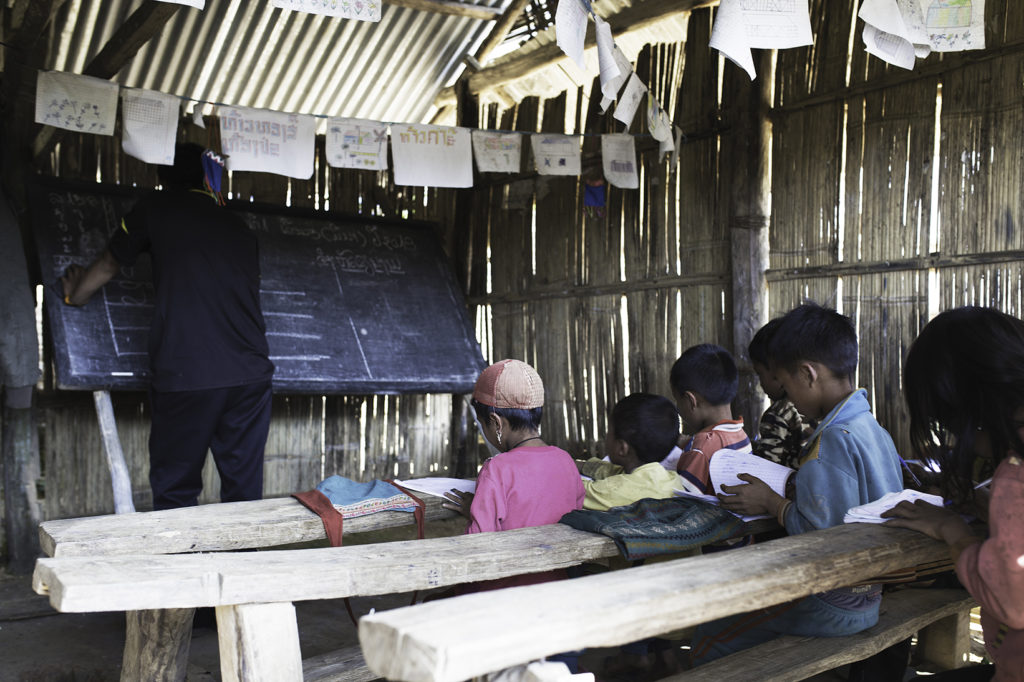Before getting ready to visit a country like Laos we need to reset all our certainties of what we think we know, because the same terms we use every day, concepts, definitions, values, verbs, in other cultures can take on a meaning completely different.
Laos is a very poor country, only the main roads are paved, fuel is expensive, the availability of products on the domestic market is modest, salaries are low and expectations of average life too. There are no railway lines, so to travel are used scooters, old and shabby buses or, for the luckiest economically, internal flights. Despite all this, it’s very rare to hear a lao complain about what is wrong or missing.
The average lao learns not to complain since he was a child. Without pacifier in the mouth and without a stroller, learn to walk and become great. It doesn’t know the concept of prohibition and obligation, lives in contact with nature and learns to make almost everything for himself. The typical citizen passively accepts everything, loves his country, sleeps a lot, works little, gets married young, gets old late and dies early. The average lao eats with his hands, doesn’t use detergent to wash dishes, doesn’t know what is the microwave or the shower, eat little and drink a lot. The typical citizen in the evening doesn’t go for an aperitif in the trendy restaurant, but sits at a roadside table made of concrete and tiles while drinking beer with friends until sleep makes it a vegetable. It doesn’t have a car, but a semi-automatic Korean scooter with which it does everything, from shopping to exceptional transport. The average lao has the elementary license, can read and write not only in his own language but also in Thai, the citizen doesn’t know the history of his country and doesn’t know how to identify it on a geographical map. To communicate remotely uses a very cheap cell phone, but it’s almost unusable because it has no money to buy the top-up. The typical citizen doesn’t go to the cinema, doesn’t read, doesn’t have a bank account, it only listens to traditional music and on television only looks at the Thai soap opera and muay thai encounters. The average lao lives well like this, has no existential problems and doesn’t seem to need anything else.


Women have enough rights
The lao woman works as much as the man, even if it isn’t uncommon, especially in some ethnic minorities, to come across ladies who work hard, who in our part of the world are traditionally male.
From a family point of view, women have more or less the same human rights, with some advantages. A family structure of matrilineal type is in force, i.e. assets are inherited by ladies. In some ethnic minorities, however, the woman enjoys very few rights. The h’mong, for example, use marrying around 15 years and a girl who arrives unmarried at 18 is considered already out of age for marriage. In cases like these, leaving the village becomes more a mandatory choice than a personal choice.

Ethnic minorities are considered subordinate
Laos is the most ethnically complex country in Southeast Asia, and one of the most complex in all of Asia. According to the most recent census of 2005, currently the ethnic minorities present in the country amount to 49. The lack of schools, water supply and sometimes even electricity relegate the inhabitants of the hill and mountain villages a condition of substantial inferiority. It is no coincidence that the highest rates of illiteracy are recorded in those areas, with the result that access to the labor market for minorities is much more difficult. The precarious condition of hospitals and mountain roads, which are transformed into mud sludge impassable during the rainy season, make traveling difficult. Many of the minorities are of animist religion, with the belief that photography steals their souls, so it’s really difficult to be able to take some pictures. An example are the lanten tribes in Luang Namtha and akha tribes in Phongsali. In both tribes women still wear traditional clothes and many customs are still intact since many years.

Lao lives in stilt house and eat everything that moves
The lao cook everything on the floor level. See older women who, with their backs bent, sit on their heels while chopping meat is something to the limits of the incredible. The traditional lunch is consumed with own hands, except for the chopsticks with which it eat noodles and the spoon with which it can drink soups and broths. Another custom is to eat all from the same plate, so the luck lies in sharing the dish with those who, before sitting down at the table, washed their hands. There are no single dishes, the plates are served all at the center of the table and each takes with own hands what he wants. The lao cuisine isn’t very varied, the dishes are practically always the same: the rice that can’t miss, vegetables, eggs, chicken, pork or beef and fish. In the territories of the h’mong ethnic minorities it’s possible to find dog meat, snakes and lizards, while in the khmu tribes the specialty is the roast mouse.

The typical dwelling of the Lao countryside is the stilt house, while in the mountain villages it’s the hut. On the first floor of the palafitte there is the sleeping area, while the ground floor is used for daytime activities: eating, chatting, cradling the children and sometimes working. Raising the sleeping area from the ground mainly comes from the need to protect the house from flooding, a frequent phenomenon during the rainy season, but also from that of preserving the place from dust. The bathroom is separated from the main house and is generally divided into two parts: on the one hand the latrine and on the other the faucet, a large tub to take a bath and a smaller basin. In some mountain villages, latrine is replaced by nature, so own physiological needs are done outdoors. We also remember that not all villages have an electrical system.

“Laos is not a place, it is a state of mind” is a phrase that we find in one of the most famous books by Tiziano Terzani and perhaps, after this article, should be clearer.
Visiting this country trying to live like the locals is the way to understand it better and certainly the one that will give more satisfaction.
Sabaidee!






